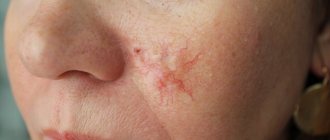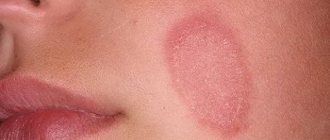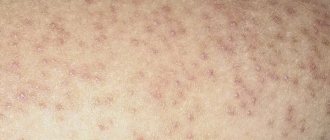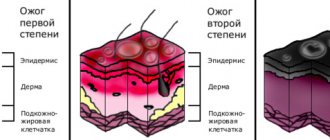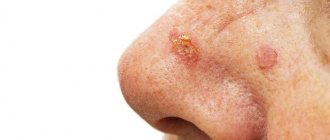Skin cancer is a malignant disease of the skin. This form of the tumor process is considered one of the most common in the world. Until now, specialists in the field of oncology have not established the exact causes of the pathological focus. Like many other oncological neoplasms, skin cancer is a multi-etiological disease. There are predisposing factors and precancerous diseases, the presence of which increases the possibility of developing a skin tumor process. Depending on the stage and type of cancer, appropriate treatment is selected. You can suspect the presence of skin cancer yourself by examining the skin, paying special attention to nevi. The prognosis for life and disease when a tumor of the skin surface is detected also depends on the form and stage of the process. In accordance with the international classification of diseases (ICD-10), skin cancer is coded C43-C44.
What formations on the skin should raise suspicion?
Most moles, brown spots and growths on the skin are harmless - but not always. If you have a lot of moles and freckles, you need to be very careful about any changes in pigmentation. When a mole begins to bleed or ooze fluid , you need to go to a dermatologist.
It is also necessary to monitor new formations on the skin. Many skin cancers are essentially colorless. They often appear as pink or pearly papules or scaly patches. These are signs of a primary neoplasm, and it is advisable to show them to the doctor. Bleeding and weeping skin lesions are of particular concern.
Character traits
A melanoma tumor developing from a nevus is characterized by a prolonged increase in changes (up to several years) and subsequent aggressive transformation (1-2 months). Early self-diagnosis and timely examination by a specialist will help identify the symptoms of melanoma:
- Smooth mirror surface, with disappearance of skin grooves.
- Increase in size, growth over the surface.
- Unpleasant sensations in the area of the mole: itching, tingling, burning.
- Dryness, peeling.
- Ulceration, bleeding.
- Signs of an inflammatory process in the area of the mole and surrounding tissues.
- The emergence of subsidiaries.
The sudden appearance of subcutaneous lumps and nodules may also indicate a developing disease.
ABCDE technique for cancer detection
The first five letters of the English alphabet are a guide to help you recognize the signs of cancer.
- A is asymmetry. Most skin cancer lesions are asymmetrical. If you draw a line through the middle of the hearth, the two halves won't line up, so it looks different from round to oval.
- B is the border. The borders of cancers tend to be jagged and may have jagged edges, while regular moles tend to have smoother, more even borders.
- C is color. Multiple colors are a warning sign. While benign moles are usually one shade of brown, cancerous moles can be various shades of tan, brown, or black. Red, white, or blue colors may also appear as they grow.
- D is the diameter. It is already worth paying attention to the spring if its size is more than 6 mm. Some experts say it's also important to look for any damage, regardless of size, that is darker than others. Sometimes, amelanotic melanomas are colorless.
- E is for evolution. Any change in the size, shape, color or height of a spot on your skin, or any new symptom in your skin, such as bleeding, itching or crusting, may be a warning sign of melanoma.
If you notice these warning signs or anything new, changing, or unusual on your skin, contact your dermatologist immediately.
Clinical classification. Types of melanoma
Melanoma manifests itself in various forms, there are 3 main types:
- Superficially widespread.
Tumor of melanocytic origin. The most common disease (70 to 75% of cases) among middle-aged Caucasians. Relatively small, complex in shape with uneven edges. The color is uneven, reddish-brown or brown, with small patches of bluish tint. The neoplasm tends to become a tissue defect, accompanied by discharge (usually bloody). Growth is possible both on the surface and in depth. The transition to the vertical growth phase can take months or even years.
Who is most at risk of skin cancer?
People with fair skin that burns easily in the sun are more likely to develop skin cancer. The skin generates its own protection against ultraviolet radiation using keratin and melanocytes , cells that produce melanin. They create a tan, protecting the skin from damage. However, when you get sunburned and your melanocytes are unable to respond quickly, you are at serious risk of developing skin cancer. Moreover, the greatest danger haunts those with blond and red hair, as they burn faster.
Therapy results
Provided adequate treatment is prescribed, recovery is observed in 95-98% of cases. But even with the correct selection of treatment tactics, in a small number of cases a recurrence of basal cell carcinoma is possible.
After removal of the tumor, the patient should be monitored by an oncologist and undergo regular examinations in order to early diagnose a possible relapse. It is also necessary to remember that the development of basal cell carcinoma is promoted by excessive exposure to ultraviolet rays. For this purpose, patients are advised to limit their exposure to the sun.
Book a consultation 24 hours a day
+7+7+78
How to detect skin cancer on the body?
The best way to detect skin cancer is to examine yourself. When checking, you should look at the spots on the skin. And you should check everything from the scalp (parting the hair to check the entire scalp) to the spaces between your toes and the soles of your feet.
If possible, ask your partner to help you. He can examine hard-to-reach areas of the scalp and back.
By getting into the habit of checking your skin, you will be able to notice changes. Checking monthly can be helpful. If you have had skin cancer, your dermatologist will be able to tell you how often you should check your skin.
People of all ages get skin cancer.
Skin testing can help you detect skin cancer early, when it is highly treatable.
Skin cancer is a malignant tumor of skin cells. In most cases, it develops as a result of exposure of the skin to ultraviolet radiation.
In the early stages, skin cancer is asymptomatic. The success of treatment depends on the type of cancer and its stage. With timely diagnosis, the disease is usually curable.
Symptoms
At first, skin cancer is usually not accompanied by any symptoms. Often a papule forms on the body - a reddened raised area on the skin.
Cancer develops primarily in areas exposed to sunlight - the face, lips, ears, scalp, neck, chest, arms and legs. However, in some cases, tumors form in areas that are rarely exposed to sunlight: on the palms of the hands, under the nails, between the fingers, on the genitals.
The disease affects skin of all shades, including dark ones. Symptoms of skin cancer depend on its type.
- Basal cell carcinoma usually affects sun-exposed areas of the skin—the face, ears, and scalp. Most often, a light papule is formed first, which quickly increases; after a few months or years, excessive local dilatation of small vessels becomes noticeable. The lesions then crust over and sometimes bleed. Basal cell carcinoma may present as:
- small dense, almost opaque nodules of light color;
- crusty papules or nodules
- flat, scar-like plaques,
- red papules or plaques.
- Squamous cell carcinoma most often affects areas of the skin exposed to the sun: the face, lips, ears and hands. It may initially appear as a red papule or plaque with a scaly surface, nodule, or warty surface. Then ulceration develops, the tumor affects the tissue. Squamous cell carcinoma may look like: firm red nodules;
- papules or plaques with a scaly surface;
- non-healing skin lesion.
- Squamous cell carcinoma most often affects areas of the skin exposed to the sun: the face, lips, ears and hands. It may initially appear as a red papule or plaque with a scaly surface, nodule, or warty surface. Then ulceration develops, the tumor affects the tissue. Squamous cell carcinoma may look like:
- Melanoma manifests itself as: flat brown uneven spots measuring 2-6 cm in diameter, covered with black dots scattered over the surface;
- plaques with raised brown edges on which red, white, black and blue spots or raised blue-black nodules form;
- papules or plaques varying in color from pearly to gray and black;
- moles that change color, size, bleeding moles, the touch of which causes pain;
- dark areas on the palms, fingers or toes, or on the mucous membranes of the mouth, nose, vagina or anus.
- Kaposi's sarcoma appears as red or purple spots on the surface of the skin and mucous membranes.
General information about the disease
Skin cancer is a malignant tumor of skin cells.
Skin is the outer covering of the human body. It performs a receptor function, participates in metabolism, and carries out thermoregulation; protects the body from mechanical and chemical influences, ultraviolet radiation, penetration of foreign substances, infections and microbes, loss and ingress of fluids.
Skin cancer occurs when normal skin cells transform into cancer cells. In a healthy body, skin cells, appearing in the required quantity, die off at a certain time, giving way to new ones. Unlike normal cells, cancer cells begin to grow uncontrollably without dying off in due time. Their accumulations form a tumor. They can spread beyond the primary focus - metastasize to adjacent tissues, lymph nodes, and other organs.
Skin cancer can be caused by ultraviolet radiation exposed to the skin from sunlight or while visiting a tanning bed. There are also additional risk factors.
Skin cancer begins in the epidermis, the top layer of skin that is a thin covering that provides protection to the deeper layers of the skin. The epidermis is constantly renewed.
The main types of skin cancer are determined according to the type of cells affected by the cancer.
- Basal cell carcinoma involves the degeneration of basal cells that produce new cells into cancer. This type occurs in approximately 80% of skin cancers. Metastasis is extremely rare, but the tumor itself can grow into surrounding tissues. As a rule, this type can be successfully treated if detected in the early stages. Recurs in 5% of cases.
- Squamous cell carcinoma involves the transformation of protective epidermal keratinocytes into cancer cells and accounts for 16% of skin cancers. It rarely metastasizes when the skin is affected, much more often when the mucous membranes are affected. If detected early, squamous cell carcinoma is highly treatable.
- Melanoma. In this case, melanocytes located in pigmented areas are affected: on the skin, mucous membranes, eyes. Melanocytes produce melanin (the pigment that gives skin its normal color) and are located in the lower part of the epidermis. When a person is frequently exposed to sunlight, melanocytes begin to actively produce melanin to protect the deeper layers of the skin. As a result, the skin tans and acquires a darker shade. This type accounts for 4% of skin cancers. The risk of melanoma metastasis depends on the depth of penetration and the extent of the process. The tumor can spread quickly; the success of treatment depends on the timeliness of its detection.
- Kaposi's sarcoma is rare and occurs most often in people with weakened immune systems—those with AIDS, those who have had organ transplants, and those taking medications that suppress the immune system. It affects blood vessels and is an aggressive form of cancer, often metastasizing to nearby tissues and lymph nodes.
Stages of skin cancer development:
- local cancer - at this stage the tumor affects only the skin;
- metastatic cancer - the tumor spreads beyond the skin, affecting nearby tissues, lymph nodes, internal organs, bones and other tissues.
Who is at risk?
- People with light skin. Cancer can occur on skin of any shade, but light-skinned people are more likely to get the disease because they have less melanin, which protects the skin from the harmful effects of ultraviolet radiation. Indicators of low melanin levels are also blond or red hair, light eyes, and a large number of freckles.
- Persons susceptible to sunburn.
- People who are overexposed to the sun, spending a lot of time in the sun or in tanning beds.
- Living in warm, sunny climates, especially in the mountains.
- People who have a large number of normal or abnormal moles on their skin. Abnormal moles are large, raised moles that may vary in size and shape. If the shape, size, or color of a mole changes, you should immediately consult a doctor.
- Persons with precancerous skin lesions (for example, with keratosis - keratinization, thickening of skin areas). Precancerous growths usually appear as hard, scaly patches of skin that are brown, red, or pink in color. Most often they appear on the face, hands, and forearms of people with fair skin.
- Persons with a hereditary predisposition to developing skin cancer.
- Skin cancer survivors. Even with successful treatment, there is a risk of getting sick again.
- People with weakened immune systems: HIV/AIDS patients, recent organ transplant recipients, leukemia patients.
- Aged people. The risk of getting sick increases with age.
Diagnostics
First of all, a thorough examination of suspicious areas of skin is carried out, then a biopsy. When the diagnosis of skin cancer is confirmed, its stage is determined, and diagnostic measures are carried out aimed at identifying metastases.
- A biopsy is the removal of cells from a suspicious area of skin to be examined under a microscope to determine the type of cancer.
- Computed tomography (CT) and magnetic resonance imaging (MRI) can detect metastases.
- Densitometry (bone scan) is used to measure bone density and detect cancer.
Treatment
Features of skin cancer treatment depend on the characteristics of the lesion, its stage, type, and condition of the patient.
- Cryodestruction (freezing). Precancerous lesions and early stage skin cancer can be removed by freezing with liquid nitrogen.
- Surgical removal of cancerous tissue and small areas of healthy skin surrounding it.
- Laser therapy. The use of a laser destroys tumors with little damage to surrounding tissue, with minimal bleeding and swelling. Used to treat superficial types of skin cancer.
- Radiation therapy. Radiation aimed at destroying cancer cells. Used when it is impossible to perform an operation.
- Chemotherapy. Drugs are used to kill cancer cells. To treat skin cancer, there are special creams and lotions containing anticancer agents.
- Photodynamic therapy. The use of special drugs - photosensitizers - and light exposure.
- Biological therapy. Stimulates the immune system to destroy cancer cells.
Prevention
- The sun should be avoided in the middle of the day, between 11 a.m. and 3 p.m. Clouds offer little or no protection to humans from harmful UV rays.
- Use sunscreen throughout the year. Creams and lotions may not protect against all harmful UV rays, but they can still reduce the risk of skin cancer. The higher the sun protection factor (SPF), the better your skin is protected. It is necessary to apply the cream not only to the face, but also to the lips, tips of the ears and all areas of the body exposed to the sun.
- You should stop visiting solariums.
Conduct self-examinations of the skin of the face, neck, ears, head, torso, arms, legs, and genitals. You also need to check all existing freckles and moles. If you notice any unusual areas or changes, consult your doctor immediately.
What does skin cancer look like? Photos and description of signs.
Skin cancer manifests itself on the body in different ways. It might look like:
- A mole that changes or a mole that looks different from your others
- Dome-shaped growth
- scaly spot
- A wound that doesn't heal or a wound that heals and comes back
- Brown or black streak under the nail
It can also manifest itself in other ways.
To detect skin cancer on your body, you don't need to memorize a long list. Contact your dermatologist if you notice a spot on your skin that:
- Differs from others
- Changed
- Itchy
- Bleeding.
Find out if the treatment is prescribed correctly
How do basal cell and squamous cell skin cancers manifest?
Most people have basal cell or squamous cell carcinoma . The most important thing to know about these types of skin cancer is that they are very superficial. They do not penetrate too deeply into the layers of the skin. Therefore, if cancer of one of these types is detected early enough, the doctor prescribes a simple resection. A dermatologist or physician may perform a biopsy to determine the nature of the growth.
Squamous cell and basal cell carcinomas are often identified by external characteristics .
It may take the form:
- clearly colored plaque;
- clusters of brown nodules;
- ulcers raised above the skin.
Such tumors are frozen, burned or excised. All of the above methods are equally effective.
It is important to start treatment as early as possible, since malignant neoplasms of these types do not grow deep into the skin . The best option is to treat cancer in Israel. In rare cases, when left untreated, basal cell and squamous cell tumors increase in size and spread into deeper layers of tissue.
Varieties
The following main types of skin cancer are distinguished:
- Basalioma. The disease develops from basal cells. This type is diagnosed more often than others (in more than 70% of cases). This form of the disease occurs without metastases.
- Squamous cell carcinoma (squamous cell carcinoma). It is characterized by intensive growth of pathogenic cells and the development of metastases formed in the lymph nodes. Subtypes of this form are infiltrating cancer (accumulation of cells mixed with lymph and blood in tissues) and papillary cancer (a tumor on the skin resembles a mushroom).
- Tumors that arise in the skin appendages - carcinoma of the appendages and hair follicles, adenocarcinoma of the sweat and sebaceous glands.
- Melanoma. Develops from skin cells that produce melanin (melanocyte). The form is dangerous because at the last stage it is almost impossible to cure.
How does melanoma manifest?
Melanoma differs from basal cell and squamous cell skin cancer primarily in that, unlike previously described types of cancer that do not penetrate into the deeper layers of tissue, this tumor has the potential to grow and spread. The deeper it penetrates the skin, the higher the risk of its further spread throughout the body. Metastatic melanoma is an extremely dangerous disease. However, melanoma can be completely cured if it is detected at an early stage, before it has time to grow deeper into the skin and form metastases in the internal organs.
Melanoma not only penetrates deeper into the skin, but individual cells spread around the primary tumor. Therefore, when resection of melanoma, the surgeon necessarily removes a fragment of normal tissue. For example, if the tumor is comparable in size to a pencil cut, you need to additionally remove about a centimeter of healthy skin around the entire circumference of the melanoma - and possibly more if the cancer has penetrated into the deeper layers of the tissue.
When melanoma grows deep into the skin, there is a risk of it spreading to other organs. Typically, in cases of metastases, secondary lesions form in the lymphatic system, namely in the lymph nodes. Lymph nodes in the armpits, groin or neck begin to enlarge and can reach considerable sizes. From there, cancer cells can spread to internal organs. Therefore, in cases of deep germination of melanoma, the doctor not only removes the tumor itself, but also checks the lymph nodes. They should not show any signs of cancer spreading.
Check the price with a specialist
Diagnostics
- Visual method. Examination of the skin using the “rule of malignancy.”
- Physical method. Palpation of accessible groups of lymph nodes.
- Dermatoscopy. Optical non-invasive surface examination of the epidermis using special devices providing 10-40x magnification.
- Siascopy. Hardware spectrophotometric analysis, which consists of intracutaneous (depth) scanning of the formation.
- X-ray.
- Ultrasound of internal organs and regional lymph nodes.
- Cytological examination
- Biopsy. It is possible to collect both the entire formation and its parts (excisional or incisional).
How the quality of medications affects the cure for skin cancer
For advanced skin cancer, especially melanoma, the main treatments are chemotherapy and immune therapy. In this case, the quality of medicines becomes of great importance. This is especially important if the patient is undergoing immune therapy, because... Such drugs are not cheap.
If you have been prescribed drug treatment for skin cancer, it is best to purchase medications in Israel.
- Counterfeiting of medicines is prohibited in Israel.
The Israeli Ministry of Health strictly controls the quality of medicines through test purchases and inspections of pharmacies. A pharmacy or pharmacist who sells a low-quality drug to a client will lose its license and face criminal charges. - In Israel, licensing of innovative drugs is carried out as quickly as possible.
This allows Israeli clinics to quickly introduce into widespread clinical practice all new effective drugs appearing in the world. - The Israeli company TEVA is a world leader in the production of medicines.
Doctors in 60 countries around the world prescribe to their patients medications developed by this company.
Treatment
- Treatment of local local injuries consists of timely detection and surgical intervention. Removal is most often performed under infiltration anesthesia. For excision of large formations, general anesthesia may be used. In addition to malignant tumors, there are a number of pre-melanoma diseases in which the surgical method is indicated.
- Local-regional damage. Treatment includes wide-area excision and lymph node dissection of the affected lymph nodes. Types of unresectable, transiently metastatic tumors are subjected to isolated regional chemoperfusion. In certain cases, a combined approach has proven itself to be effective, with additional therapy that stimulates the immune system.
- Treatment of distant metastases is performed with monomodal chemotherapy. Certain types of mutations are targeted by targeted drugs.
Where can I buy Israeli medicines?
- In an Israeli pharmacy - after consulting a doctor.
If you undergo examination at the oncology center, the doctor will prescribe you the necessary medications, which can be purchased in Israel. - At your place of residence - using a telemedicine program.
As part of this program, you will also receive a consultation from an Israeli doctor - but remotely. You can order the medications prescribed by him and have them delivered to your home.
Cost of diagnosing skin cancer in Israel
In the table below, we present the cost of some procedures prescribed for the diagnosis of skin cancer at the Ikhilov Cancer Center.
| Diagnostic and treatment procedures | Price |
| PET-CT | $1491 |
| Examination and consultation with an oncologist-dermatologist | $567 |
| Biopsy revision | $511 |
| Operation Mohsa | $3318 |
| Photodynamic therapy | $361 |
| Removal of epidermal carcinoma | $511 |
| Detailed blood test | $407 |
Read more about the dangers of solarium
Scientists have proven the connection between solarium and skin cancer. American researchers provide terrifying statistics: about 430,000 cases of skin cancer are associated with visiting solariums. Other studies also confirm the dangers of this procedure.
It has been proven that 2 out of 3 people who regularly visit a solarium sooner or later develop skin cancer. Even a one-time visit to such a procedure increases the likelihood of cancer by 20%. And, if a person attended 150-170 sessions, then the risk increases by 50%. This number of sessions “accumulates” in 10-15 years, if you go approximately once a month.
The great harm of solariums is explained by the fact that the radiation from the lamps of the device consists of 98% of waves of the most carcinogenic type - waves of the UVA spectrum.
Why is it worth treating skin cancer in Israel, at the Ichilov Cancer Center?
- Accurate diagnosis.
Modern research methods and extensive experience of Israeli oncologists and pathologists, gained in leading cancer centers in the world, make it possible to accurately determine the type and stage of cancer in order to select the optimal treatment program. - World-class specialists.
The treatment of skin cancer at the oncology center is carried out by top-class professionals, such as oncologist Professor Yakov Shekhter, the author of his own method of immune therapy for metastatic melanoma. The professor selects a personalized treatment protocol for each patient, which allows him to achieve the best possible results. - Innovative treatment methods.
For skin cancer, the oncology center uses:
- Alpha-DaRT brachytherapy is a safe method for removing non-melanoma skin cancer;
- therapy of metastatic melanoma using the TIL protocol (tumor infiltration with lymphocytes).
You can take the first step towards recovery right now. To do this, fill out an application and one of our doctors will contact you within 2 hours.
Or call: +972-3-376-03-58 in Israel and +7-495-777-6953 in Russia.
This consultation does not oblige you to anything and is completely free .
We guarantee you complete confidentiality and preservation of medical confidentiality. We will help you, just as we have helped other patients. [starbox]
Causes of skin tumors
In rare cases, a skin tumor is caused by one reason; as a rule, there is a complex of reasons:
- ultraviolet irradiation;
- heredity;
- exposure to aggressive chemicals - arsenic, tar, resins, fuels and lubricants. The process leads to mutations in skin cells and triggers the degeneration of healthy tissues;
- exposure to radiation, which provokes the appearance of atypical cells;
- changes in scar tissue formed after burns or deep wounds;
- transformation of moles due to an excess of melanin. A minor injury or sunburn causes their accumulation to accelerate their growth and degenerate into cancer.
Some diseases are considered precancerous and in most cases develop into cancer. These include: Bowen's, Paget's, Keir's diseases, congenital hypersensitivity to ultraviolet radiation.
Some of the reasons are diseases that can become malignant under the influence of ultraviolet radiation, poor ecology, pathologies of the endocrine system, and bad habits. These include: trophic ulcers, skin manifestations of syphilis, tuberculosis, lupus erythematosus, cutaneous horn, thickening and keratinization of the skin in old age, senile keratoma.
